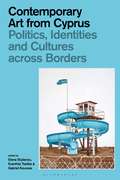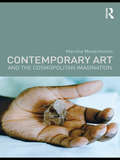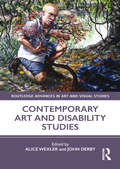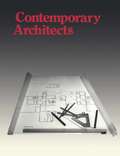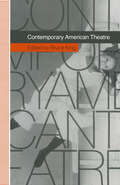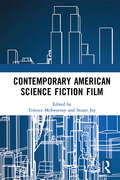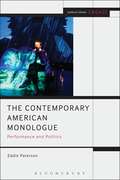- Table View
- List View
Contemporary Art from Cyprus: Politics, Identities, and Cultures across Borders
To what extent does locality influence contemporary art? Can any particular artistic practices be defined as uniquely Cypriot? And does art from Cyprus transcend Western boundaries once it enters the global art scene?This volume uses Cyprus as a case study for the exploration of notions of identity, regionalism, and the global and local in contemporary art practice; it is not, therefore, a complete historiography of contemporary Cypriot art. Rather, this critical text provides a theoretical and historical framework that frames and contextualizes art practices from Cyprus, while always relating these back to the international art world.Numerous current and pressing issues-all relevant beyond Cyprus-are investigated in this book including, but not limited to, art as capital, the emergence of the “periphery”, the importance of thriving localities, issues of memory and memorialization, archaeology, artists' identities, conflict and politics, social engagement, gender politics, and such curatorial alternatives as artist-run spaces. In doing all of this, Contemporary Art from Cyprus not only bears on current and future art practices in this region but highlights the importance of Cypriot art in a global context too.
Contemporary Art Biennials in Europe: The Work of Art in the Complex City
by Nicolas WhybrowThrough its examination of five quite different art events in cities across Europe, Contemporary Art Biennials in Europe offers a compelling exploration of how public art takes place in the modern city. Roughly tracing a central horizontal trajectory from the western to the eastern edges of the continent, Nicolas Whybrow considers the Folkestone Triennial in the UK, Sculpture Projects Münster in Germany, the Venice Biennale in Italy, Belgrade's Mikser Festival in Serbia and the Istanbul Biennial in Turkey.Writing within the context of a thirty-year international 'biennial boom', Whybrow interrogates the extent to which biennial events and their artworks seek to engage with the socio-cultural and political complexity of cities, in particular the work that is involved in this relationship. With its focus on Europe, he also tells a composite story of continental difference at a moment of high tension, centering on issues of migration, political populism and uncertainty around the future form of the European Union.
Contemporary Art Biennials in Europe: The Work of Art in the Complex City
by Nicolas WhybrowThrough its examination of five quite different art events in cities across Europe, Contemporary Art Biennials in Europe offers a compelling exploration of how public art takes place in the modern city. Roughly tracing a central horizontal trajectory from the western to the eastern edges of the continent, Nicolas Whybrow considers the Folkestone Triennial in the UK, Sculpture Projects Münster in Germany, the Venice Biennale in Italy, Belgrade's Mikser Festival in Serbia and the Istanbul Biennial in Turkey.Writing within the context of a thirty-year international 'biennial boom', Whybrow interrogates the extent to which biennial events and their artworks seek to engage with the socio-cultural and political complexity of cities, in particular the work that is involved in this relationship. With its focus on Europe, he also tells a composite story of continental difference at a moment of high tension, centering on issues of migration, political populism and uncertainty around the future form of the European Union.
Contemporary Art and Unforgetting in Colonial Landscapes: Islands of Empire (Palgrave Macmillan Memory Studies)
by Kate McMillanThis book explores the work of artists based in the global south whose practices and methods interrogate and explore the residue of Empire. In doing so, it highlights the way that contemporary art can assist in the un-forgetting of colonial violence and oppression that has been systemically minimized. The research draws from various fields including memory studies; postcolonial and decolonial strategies of resistance; activism; theories of the global south; the intersection between colonialism and the Anthropocene, as well as practice-led research methodologies in the visual arts. Told through the author’s own perspective as an artist and examining the work of Julie Gough, Yuki Kihara, Megan Cope, Yhonnie Scarce, Lisa Reihana and Karla Dickens, the book develops a number of unique theories for configuring the relationship between art and a troubled past.
Contemporary Art and the Cosmopolitan Imagination
by Marsha MeskimmonContemporary Art and the Cosmopolitan Imagination explores the role of art in conceiving and reconfiguring the political, ethical and social landscape of our time. Understanding art as a vital form of articulation, Meskimmon argues that artworks do more than simply reflect and represent the processes of transnational and transcultural exchange typical of the global economy. Rather, art can change the way we imagine, understand and engage with the world and with others very different than ourselves. In this sense, art participates in a critical dialogue between cosmopolitan imagination, embodied ethics and locational identity. The development of a cosmopolitan imagination is crucial to engendering a global sense of ethical and political responsibility. By materialising concepts and meanings beyond the limits of a narrow individualism, art plays an important role in this development, enabling us to encounter difference, imagine change and make possible the new. This book asks what it means to inhabit a globalized world – how we might literally and figuratively make ourselves cosmopolitans, ‘at home’ everywhere. Contemporary art provides a space for this enquiry. Contemporary Art and the Cosmopolitan Imagination is structured and written through four ‘architectonic figurations’ – foundation, threshold, passage and landing – which simultaneously reference the built environment and the transformative structure of knowledge-systems. It offers a challenging new direction in the current literature on cosmopolitanism, globalisation and art.
Contemporary Art and the Cosmopolitan Imagination
by Marsha MeskimmonContemporary Art and the Cosmopolitan Imagination explores the role of art in conceiving and reconfiguring the political, ethical and social landscape of our time. Understanding art as a vital form of articulation, Meskimmon argues that artworks do more than simply reflect and represent the processes of transnational and transcultural exchange typical of the global economy. Rather, art can change the way we imagine, understand and engage with the world and with others very different than ourselves. In this sense, art participates in a critical dialogue between cosmopolitan imagination, embodied ethics and locational identity. The development of a cosmopolitan imagination is crucial to engendering a global sense of ethical and political responsibility. By materialising concepts and meanings beyond the limits of a narrow individualism, art plays an important role in this development, enabling us to encounter difference, imagine change and make possible the new. This book asks what it means to inhabit a globalized world – how we might literally and figuratively make ourselves cosmopolitans, ‘at home’ everywhere. Contemporary art provides a space for this enquiry. Contemporary Art and the Cosmopolitan Imagination is structured and written through four ‘architectonic figurations’ – foundation, threshold, passage and landing – which simultaneously reference the built environment and the transformative structure of knowledge-systems. It offers a challenging new direction in the current literature on cosmopolitanism, globalisation and art.
Contemporary Art and Memory: Images of Recollection and Remembrance
by Joan GibbonsWhether exploring the intimate recollections which make up the artist's own life history or questioning the way the gallery and museum present public memory, contemporary art, it would seem, is haunted by the past. "Contemporary Art and Memory" is the first accessible survey book to explore the subject of memory as it appears in its many guises in contemporary art. Looking at both personal and public memory, Gibbons explores art as autobiography, the memory as trace, the role of the archive, revisionist memory and postmemory, as well as the absence of memory in oblivion. Grounding her discussion in historical precedents, Gibbons explores the work of a wide range of international artists including Yinka Shonibare MBE, Doris Salcedo, Keith Piper, Jeremy Deller, Judy Chicago, Louise Bourgeois, Tracey Emin, Felix Gonzalez-Torres, Christian Boltanski, Janet Cardiff, Bill Fontana, Pierre Huyghe, Susan Hiller, Japanese photographer Miyako Ishiuchi and new media artist George Legrady."Contemporary Art and Memory" will be indispensable to all those concerned with the ways in which artists represent and remember the past.?????
Contemporary Art and Memory: Images of Recollection and Remembrance
by Joan GibbonsWhether exploring the intimate recollections which make up the artist's own life history or questioning the way the gallery and museum present public memory, contemporary art, it would seem, is haunted by the past. 'Contemporary Art and Memory' is the first accessible survey book to explore the subject of memory as it appears in its many guises in contemporary art. Looking at both personal and public memory, Gibbons explores art as autobiography, the memory as trace, the role of the archive, revisionist memory and postmemory, as well as the absence of memory in oblivion. Grounding her discussion in historical precedents, Gibbons explores the work of a wide range of international artists including Yinka Shonibare MBE, Doris Salcedo, Keith Piper, Jeremy Deller, Judy Chicago, Louise Bourgeois, Tracey Emin, Felix Gonzalez-Torres, Christian Boltanski, Janet Cardiff, Bill Fontana, Pierre Huyghe, Susan Hiller, Japanese photographer Miyako Ishiuchi and new media artist George Legrady. 'Contemporary Art and Memory' will be indispensable to all those concerned with the ways in which artists represent and remember the past.
Contemporary Art and Disability Studies (Routledge Advances in Art and Visual Studies)
by Alice Wexler John DerbyThis book presents interdisciplinary scholarship on art and visual culture that explores disability in terms of lived experience. It will expand critical disability studies scholarship on representation and embodiment, which is theoretically rich, but lacking in attention to art. It is organized in five thematic parts: methodologies of access, agency, and ethics in cultural institutions; the politics and ethics of collaboration; embodied representations of artists with disabilities in the visual and performing arts; negotiating the outsider art label; and first-person reflections on disability and artmaking. This volume will be of interest to scholars who study disability studies, art history, art education, gender studies, museum studies, and visual culture.
Contemporary Art and Disability Studies (Routledge Advances in Art and Visual Studies)
by Alice Wexler John DerbyThis book presents interdisciplinary scholarship on art and visual culture that explores disability in terms of lived experience. It will expand critical disability studies scholarship on representation and embodiment, which is theoretically rich, but lacking in attention to art. It is organized in five thematic parts: methodologies of access, agency, and ethics in cultural institutions; the politics and ethics of collaboration; embodied representations of artists with disabilities in the visual and performing arts; negotiating the outsider art label; and first-person reflections on disability and artmaking. This volume will be of interest to scholars who study disability studies, art history, art education, gender studies, museum studies, and visual culture.
Contemporary Art: 1989 to the Present
by Alexander DumbadzeAn engaging account of today’s contemporary art world that features original articles by leading international art historians, critics, curators, and artists, introducing varied perspectives on the most important debates and discussions happening around the world. Features a collection of all-new essays, organized around fourteen specific themes, chosen to reflect the latest debates in contemporary art since 1989 Each topic is prefaced by an introduction on current discussions in the field and investigated by three essays, each shedding light on the subject in new and contrasting ways Topics include: globalization, formalism, technology, participation, agency, biennials, activism, fundamentalism, judgment, markets, art schools, and scholarship International in scope, bringing together over forty of the most important voices in the field, including Sofía Hernández Chong Cuy, David Joselit, Michelle Kuo, Raqs Media Collective, and Jan Verwoert A stimulating guide that will encourage polemical interventions and foster critical dialogue among both students and art aficionados
Contemporary Art: 1989 to the Present
by Alexander Dumbadze Suzanne HudsonAn engaging account of today’s contemporary art world that features original articles by leading international art historians, critics, curators, and artists, introducing varied perspectives on the most important debates and discussions happening around the world. Features a collection of all-new essays, organized around fourteen specific themes, chosen to reflect the latest debates in contemporary art since 1989 Each topic is prefaced by an introduction on current discussions in the field and investigated by three essays, each shedding light on the subject in new and contrasting ways Topics include: globalization, formalism, technology, participation, agency, biennials, activism, fundamentalism, judgment, markets, art schools, and scholarship International in scope, bringing together over forty of the most important voices in the field, including Sofía Hernández Chong Cuy, David Joselit, Michelle Kuo, Raqs Media Collective, and Jan Verwoert A stimulating guide that will encourage polemical interventions and foster critical dialogue among both students and art aficionados
Contemporary Argentine Women Filmmakers
by Mirna Vohnsen Daniel MourenzaThis edited volume offers a wide-ranging picture of Argentine women filmmakers’ contribution to the film industry from the 1980s to the present by bringing together the work of highly acclaimed and emerging directors. Through thirteen critical essays by leading scholars in the field of Argentine cinema, the book acknowledges that contemporary women filmmakers have transformed the cinema of Argentina by questioning, challenging and debunking hegemonic patriarchal systems of representation. With a focus on women’s voices and experiences, the contributions redress both the under-representation of women and girls onscreen and the perpetuation of stereotypes, while exploring the innovative aesthetics used by these filmmakers.
Contemporary Architecture and the Digital Design Process
by Peter SzalapajContemporary Architecture and the Digital Design Process introduces the reader to new developments in the computer modelling of design form in contemporary architectural practice through a series of detailed case studies. The book illustrates how evolving design practices use and exploit the potential of new computing technologies in a wide range of areas and application.A central thesis of this book is that technology follows design demand, rather than design adjusting to available new technology. Designers are not merely passive recipients of prescribed computing tools and techniques. Instead, they are increasingly able to express their intuitive design ideas through the rational medium of computing.The book features several contemporary building projects, each of which introduces a range of CAD and computing issues based upon the work of creative architectural and engineering design practices. These include the offices of Frank O. Gehry, Peter Cook and Colin Fournier, Anthony Hunt Associates, Peter Hubner, Szyskowitz-Kowalski, and Faulkner Brown. All these examples show what architects need to know and the skills they need to acquire to use advanced CAD technology.
Contemporary Architecture and the Digital Design Process
by Peter SzalapajContemporary Architecture and the Digital Design Process introduces the reader to new developments in the computer modelling of design form in contemporary architectural practice through a series of detailed case studies. The book illustrates how evolving design practices use and exploit the potential of new computing technologies in a wide range of areas and application.A central thesis of this book is that technology follows design demand, rather than design adjusting to available new technology. Designers are not merely passive recipients of prescribed computing tools and techniques. Instead, they are increasingly able to express their intuitive design ideas through the rational medium of computing.The book features several contemporary building projects, each of which introduces a range of CAD and computing issues based upon the work of creative architectural and engineering design practices. These include the offices of Frank O. Gehry, Peter Cook and Colin Fournier, Anthony Hunt Associates, Peter Hubner, Szyskowitz-Kowalski, and Faulkner Brown. All these examples show what architects need to know and the skills they need to acquire to use advanced CAD technology.
Contemporary Approaches to Adaptation in Theatre (Adaptation in Theatre and Performance)
by Kara ReillyThis book examines contemporary approaches to adaptation in theatre through seventeen international case studies. It explores company and directorial approaches to adaptation through analysis of the work of Kneehigh, Mabou Mines, Robert Le Page and Katie Mitchell. It then moves on to look at the transformation of the novel onto the stage in the work of Mitchell, and in The Red Badge of Courage, The Kite Runner, Anne Frank, and Fanny Hill. Next, it examines contemporary radical adaptations of Trojan Women and The Iliad. Finally, it looks at five different approaches to postmodern metatheatrical adaptation in early modern texts of Hamlet, The Changeling, and Faustus, as well as the work of the Neo-Futurists, and the mash-up Medea/Macbeth/Cinderella. Overall, this comprehensive study offers insights into key productions, ideas about approaches to adaptation, and current debates on fidelity, postmodernism and remediation.
Contemporary American Science Fiction Film
by Terence McSweeneyContemporary American Science Fiction Film explores and interrogates a diverse variety of popular and culturally relevant American science fiction films made in the first two decades of the new millennium, offering a ground-breaking investigation of the impactful role of genre cinema in the modern era. Placing one of the most popular and culturally resonant American film genres broadly within its rich social, historical, industrial, and political context, the book interrogates some of the defining critical debates of the era via an in-depth analysis of a range of important films. An international team of authors draw on case studies from across the science fiction genre to examine what these films can tell us about the time period, how the films themselves connect to the social and political context, how the fears and anxieties they portray resonate beyond the screen, and how the genre responds to the shifting coordinates of the Hollywood film industry. Offering new insights and perspectives on the cinematic science fiction genre, this volume will appeal primarily to scholars and students of film, television, cultural and media studies, as well as anyone interested in science fiction and speculative film.
Contemporary American Science Fiction Film
by Terence McSweeney Stuart JoyContemporary American Science Fiction Film explores and interrogates a diverse variety of popular and culturally relevant American science fiction films made in the first two decades of the new millennium, offering a ground-breaking investigation of the impactful role of genre cinema in the modern era. Placing one of the most popular and culturally resonant American film genres broadly within its rich social, historical, industrial, and political context, the book interrogates some of the defining critical debates of the era via an in-depth analysis of a range of important films. An international team of authors draw on case studies from across the science fiction genre to examine what these films can tell us about the time period, how the films themselves connect to the social and political context, how the fears and anxieties they portray resonate beyond the screen, and how the genre responds to the shifting coordinates of the Hollywood film industry. Offering new insights and perspectives on the cinematic science fiction genre, this volume will appeal primarily to scholars and students of film, television, cultural and media studies, as well as anyone interested in science fiction and speculative film.
The Contemporary American Monologue: Performance and Politics (Methuen Drama Engage)
by Eddie Paterson Enoch Brater Mark Taylor-BattyTalk-show confessions, online rants, stand-up routines, inspirational speeches, banal reflections and calls to arms: we live in an age of solo voices demanding to be heard. In The Contemporary American Monologue Eddie Paterson looks at the pioneering work of US artists Spalding Gray, Laurie Anderson, Anna Deavere Smith and Karen Finley, and the development of solo performance in the US as a method of cultural and political critique. Ironic confession, post-punk poetry, investigations of race and violence, and subversive polemic, this book reveals the link between the rise of radical monologue in the late 20th century and history of speechmaking, politics, civil rights, individual freedom and the American Dream in the United States. It shows how US artists are speaking back to the cultural, political and economic forces that shape the world.Eddie Paterson traces the importance of the monologue in Shakespeare, Brecht, Beckett, Chekov, Pinter, O'Neill and Williams, before offering a comprehensive analysis of several of the most influential and innovative American practitioners of monologue performance. The Contemporary American Monologue constitutes the first book-length account of US monologists that links the tradition of oratory and speechmaking in the colony to the appearance of solo performance as a distinctly American phenomenon.
The Contemporary American Monologue: Performance and Politics (Methuen Drama Engage)
by Eddie Paterson Enoch Brater Mark Taylor-BattyTalk-show confessions, online rants, stand-up routines, inspirational speeches, banal reflections and calls to arms: we live in an age of solo voices demanding to be heard. In The Contemporary American Monologue Eddie Paterson looks at the pioneering work of US artists Spalding Gray, Laurie Anderson, Anna Deavere Smith and Karen Finley, and the development of solo performance in the US as a method of cultural and political critique. Ironic confession, post-punk poetry, investigations of race and violence, and subversive polemic, this book reveals the link between the rise of radical monologue in the late 20th century and history of speechmaking, politics, civil rights, individual freedom and the American Dream in the United States. It shows how US artists are speaking back to the cultural, political and economic forces that shape the world.Eddie Paterson traces the importance of the monologue in Shakespeare, Brecht, Beckett, Chekov, Pinter, O'Neill and Williams, before offering a comprehensive analysis of several of the most influential and innovative American practitioners of monologue performance. The Contemporary American Monologue constitutes the first book-length account of US monologists that links the tradition of oratory and speechmaking in the colony to the appearance of solo performance as a distinctly American phenomenon.
Contemporary American Jewelry Design
by Ettagale BlauerThe Phenomenon of Studio Goldsmithing When the history of art in the 1980s is written, much of it will be etched in gold. This is the time of the contemporary goldsmith, an artist who chooses to work in precious metals rather than oils or marble. The contemporary jeweler-as-artist has only recently become a re cognized force. With rare exceptions, the whole field is little more than thirty years old. But it is only within the past fifteen years that these jewelers have entered the jewelry mainstream. The phenomenon of contemporary goldsmithing embraces an eclectic group of artists, each with a unique vision, each taking a per sonal path to jewelry producing. They have as little relationship to the typical, mass-produced jewelry as a champagne maker has to a bottler of orange soda. They approach a piece of art, not a piece of metal. The work is personal and a perfect expression of the "back to the land" movement that spawned it. Many of these goldsmiths were looking not merely for a way to make a living but for a way to make a life that was worthy of living. Running a business while trying to remain a creative metalsmith at the same time is the ongoing challenge. The jeweler-artists have solved or resolved these often conflicting needs in slightly different ways and in a beautiful variety of techniques and styles. Their meth ods, their growth, and their work are discussed here.
Contemporary American Independent Film: From the Margins to the Mainstream
by Chris Holmlund Justin WyattFrom Easy Rider to The Blair Witch Project, this book is a comprehensive examination of the independent film scene. Exploring the uneasy relationship between independent films and the major studios, the contributors trace the changing ideas and definitions of independent cinema, and the diversity of independent film practices. They consider the ways in which indie films are marketed and distributed, and how new technologies such as video, cable and the internet, offered new opportunities for filmmakers to produce and market independent films. Turning to the work of key auteurs such as John Sayles and Haile Gerima, contributors ask whether independent filmmakers can also be stars, and consider how indie features like Boys Don't Cry and Shopping for Fangs address issues of gender, sexuality and ethnicity normally avoided by Hollywood. For all students of film studies and American studies, this cultural journey through independent film history will be an absolute must read.
Contemporary American Independent Film: From the Margins to the Mainstream
by Christine Holmlund Justin WyattFrom Easy Rider to The Blair Witch Project, this book is a comprehensive examination of the independent film scene. Exploring the uneasy relationship between independent films and the major studios, the contributors trace the changing ideas and definitions of independent cinema, and the diversity of independent film practices. They consider the ways in which indie films are marketed and distributed, and how new technologies such as video, cable and the internet, offered new opportunities for filmmakers to produce and market independent films. Turning to the work of key auteurs such as John Sayles and Haile Gerima, contributors ask whether independent filmmakers can also be stars, and consider how indie features like Boys Don't Cry and Shopping for Fangs address issues of gender, sexuality and ethnicity normally avoided by Hollywood. For all students of film studies and American studies, this cultural journey through independent film history will be an absolute must read.
